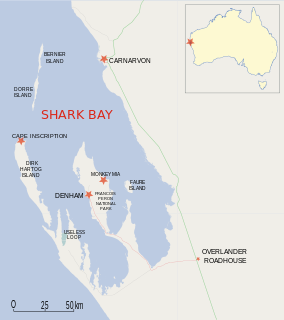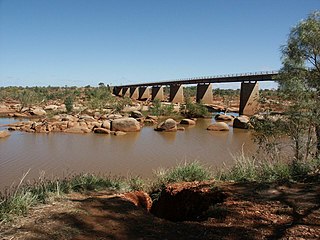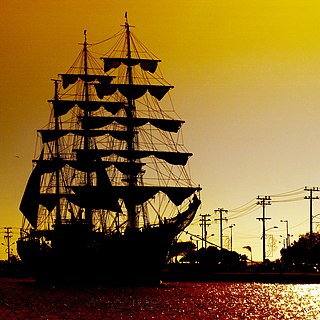
Abel Janszoon Tasman was a Dutch seafarer, explorer, and merchant, best known for his voyages of 1642 and 1644 in the service of the Dutch East India Company (VOC). He was the first known European explorer to reach the islands of Van Diemen's Land and New Zealand, and to sight the Fiji islands.

The maritime European exploration of Australia consisted of several waves of white European seafarers that sailed the edges of the Australian continent. Dutch navigators were the first Europeans known to have explored and mapped the Australian coastline. The first documented encounter was that of Dutch navigator Willem Janszoon, in 1606. Dutch seafarers also visited the west and north coasts of the continent, as did French explorers.

Jacob Le Maire was a Dutch mariner who circumnavigated the earth in 1615 and 1616. The strait between Tierra del Fuego and Isla de los Estados was named the Le Maire Strait in his honor, though not without controversy. It was Le Maire himself who proposed to the council aboard Eendracht that the new passage should be called by his name and the council unanimously agreed with Le Maire. The author or authors of The Relation took Eendracht captain Schouten’s side by proclaiming:

Dirk Hartog was a 17th-century Dutch sailor and explorer. Dirk Hartog's expedition was the second European group to land in Australia and the first to leave behind an artefact to record his visit, the Hartog plate. His name is sometimes alternatively spelled Dirck Hartog or Dierick Hartochszch. Ernest Giles referred to him as Theodoric Hartog.

Dirk Hartog Island is an island off the Gascoyne coast of Western Australia, within the Shark Bay World Heritage Area. It is about 80 kilometres long and between 3 and 15 kilometres wide and is Western Australia's largest and most western island. It covers an area of 620 square kilometres and is approximately 850 kilometres north of Perth. It was named after Dirk Hartog, a Dutch sea captain, who first encountered the Western Australian coastline close to the 26th parallel south latitude, which runs through the island. After leaving the island, Hartog continued his voyage north-east along the mainland coast. Hartog gave the Australian mainland one of its earliest known names, as Eendrachtsland, which he named after his ship Eendracht, meaning "Unity".
The human history of Western Australia commenced between 40,000 and 60,000 years ago with the arrival of Indigenous Australians on the northwest coast. The first inhabitants expanded the range of their settlement to the east and south of the continent. The first recorded European contact was in 1616, when Dutch explorer Dirk Hartog landed on the west coast, having been blown off course while en route to Batavia, nowadays called Jakarta.

Duyfken, also spelled Duifken or Duijfken, was a small ship built in the Dutch Republic. She was a fast, lightly armed ship probably intended for shallow water, small valuable cargoes, bringing messages, sending provisions, or privateering. The tonnage of Duyfken has been given as 25-30 lasten.

Willem Cornelisz Schouten was a Dutch navigator for the Dutch East India Company. He was the first to sail the Cape Horn route to the Pacific Ocean.
The Eendracht was an early 17th Century Dutch wooden-hulled 700 tonne East Indiaman, launched in 1615 in the service of the Dutch East India Company(VOC). It was captained by Dirk Hartog when he made the second recorded landfall by a European on Australian soil, in 1616.

The Ashburton River is located within the Pilbara region of Western Australia.

Eendrachtsland or Eendraghtsland was derived from 't Landt van d'Eendracht or Land van de Eendracht and was one of the earliest names given for Australia, being in use for 28 years, from 1616 until 1644.

Hartog Plate or Dirk Hartog's Plate is either of two plates, although primarily the first, which were left on Dirk Hartog Island during a period of European exploration of the western coast of Australia prior to European settlement there. The first plate, left by Dutch explorer Dirk Hartog, is the oldest-known artifact of European exploration in Australia still in existence. The original dish was returned to the Netherlands where it is on display in the Rijksmuseum. A replacement and additional dish were subsequently discovered on three additional visits over the next 200 years

Willem Janszoon made the first recorded European landing on the Australian continent in 1606, sailing from Bantam, Java, in the Duyfken. As an employee of the Dutch East India Company, Janszoon had been instructed to explore the coast of New Guinea in search of economic opportunities. He had originally arrived in Dutch East Indies from the Netherlands in 1598 and became an officer of the VOC on its establishment in 1602.

Leeuwin was a Dutch galleon that discovered and mapped some of the southwest corner of Australia in March 1622. In this way it became only the seventh European ship to sight the continent.

Of an estimated 200 place names the Dutch bestowed on Australian localities in the 17th century as a result of the Dutch voyages of exploration along the western, northern and southern Australian coasts, only about 35 can still be found on current maps. Five out of six names were either renamed or forgotten or their locations were lost. Other places were named after the early Dutch explorers by later British explorers or colonists, for instance the Australian state of Tasmania is named after Abel Tasman. Australia itself was called New Holland by the English and Nieuw Holland by the Dutch.








![Caert van't Landt van d'Eendracht (detail naming the Mauritius as ship used for the discovery of the Willems River) by Hessel Gerritsz, stating, Willems revier, besocht by 't volck van 't Schip Mauritius in Iulius Adeg 1618 ("Willem's River, visited by the crew of the ship Mauritius in July 1618"). [This cropped image has been reoriented 90 degrees right from the original chart with north to top] Caert van't Landt van d'Eendracht (detail showing Willems River).jpg](http://upload.wikimedia.org/wikipedia/commons/e/ea/Caert_van%27t_Landt_van_d%27Eendracht_%28detail_showing_Willems_River%29.jpg)











